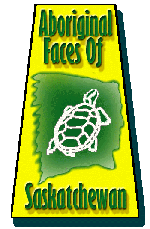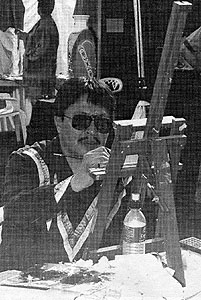|
 |
||||||||
Day Star artist paints himself a colorful future By Rob McKinley Reprinted
with permission from
"It's a combination of extremes. It's extreme realism and extreme abstraction. That's why I call it semi-abstraction," said Kapay, who was one of 85 artists and vendors attending the Spirits in the Sun Indigenous Arts Festival in Scottsdale, Arizona, from Feb. 6 to 8. His booth was one of 23 featuring works of prairie region artists. Other Saskatchewan vendors included Red Quill Studios and Sweetgrass Records, from Saskatoon; The Hart House Tea Room and Crafts from Punnichy; Wanuskewin Heritage Park from Saskatoon; and the Saskatchewan Indian Cultural Centre, also from Saskatoon. Other Native art from Sakatchewan was showcased at the Spirits in the Sun gallery exhibits at the Hyatt Regency Hotel in Scottsdale. There, the Mahigan Gallery of Borden displayed the works of Lloyd Noel Pinay. Thirty-nine other galleries from across Canada were featured in the lavish hotel's setting. The galleries represented 300 Canadian Native artists and their work. Kapay's acrylic on canvas paintings carefully capture traditions, spirituality and symbols of Native life. Kapay, a Cree, who was born on the Day Star First Nation, 200 km northeast of Regina, went to the Native arts festival to introduce his work to potential buyers in the southwestern United States. In Canada, Kapay's work has already received high praise, and this is only his fifth year working as a professional artist. Aside for the "semi-abstraction" works, Kapay also created images of landscapes, people and animals in pastel colors which provide insight into Native spirituality and evoke hidden emotions. "I draw on my people for inspiration. My paintings are a conglomeration of images brought on by my many years on the Day Star reserve and what I've learned of our lives over the centuries," he said. In all of his works with people or animals, a main focal point is the eyes. Looking into the eyes of one of his painted eagles, it almost seems possible that the image could soar from the canvas. Looking into the eyes of one of his wolves again provokes many emotions. Kapay knows the eyes are important; they are the windows to the paintings' meanings, he said. "The eyes -- I need to make sure that they are accurate; otherwise, it throws the whole painting off," he said. The artist attracted the attention of many people at the festival. Many stopped at his booth to watch him work, to gaze at his pieces or just to talk. One lady, transplanted to Arizona from Regina, spent several minutes discussing her old home town with Kapay. He said the socializing and mingling is what made the festival a success for him. He also like the Arizona sunshine, in contrast to the cooler temperatures in Regina in early February. Kapay's art ranges in price from $110 up to $5,000. One of his latest works will soon be seen on the cover of the book Red Coats on the Prairies, a 125-year history of the Northwest Mounted Police. |
|||||||||








